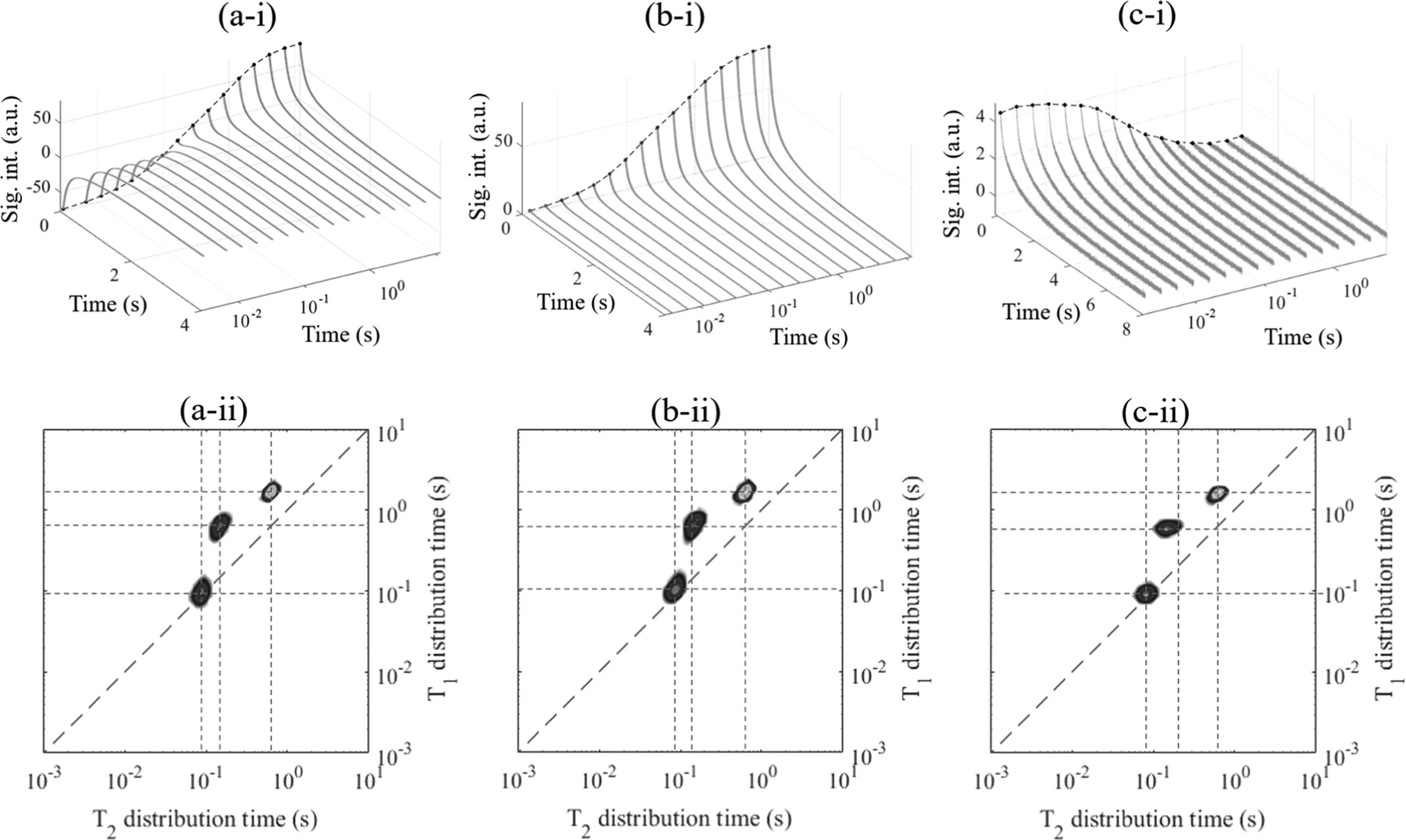Using T1 as a direct detection dimension in two-dimensional time-domain NMR experiments using CWFP regime.
MONARETTO, Tatiana; MONTRAZI, Elton Tadeu; MORAES, Tiago Bueno; SOUZA, André Alves de; RONDEAU-MOURO, Corinne; COLNAGO, Luiz Alberto.
MONARETTO, Tatiana; MONTRAZI, Elton Tadeu; MORAES, Tiago Bueno; SOUZA, André Alves de; RONDEAU-MOURO, Corinne; COLNAGO, Luiz Alberto.




 Abstract: The transverse relaxation time (T2), measured with Carr-Purcell-Meiboom-Gill (CPMG) sequence, has been widely used to obtain the direct dimension data in two-dimension time domain NMR (2D TDNMR). In this paper we are demonstrating that Continuous Wave Free Precession sequence, with low flip angle (CWFP-T1), can be an alternative to CPMG as direct detection dimension. CWFP-T1 is a fast single shot sequence, like CPMG, and yields an exponential signal governed predominantly by the longitudinal (T1) relaxation time. To obtain the correlations between T1 and T2 (T1-T2 maps) we are proposing the use of CPMG-CWFP-T1 pulse sequence. In this sequence CPMG encodes T2 information (indirect dimension) that modulates the CWFP-T1 (direct dimension) signal amplitudes. CPMG-CWFP-T1 experiments were compared with classical 2D sequences such as Saturation-Recovery-CPMG (SR-CPMG) and Inversion- Recovery-CPMG (IR-CPMG) sequence and yields similar results in phantom sample. The experimental time for the 2D sequences, using single scan, shows that SR-CPMG CPMG-CWFP-T1 < IR-CPMG. Experimental and simulated results demonstrated that 2D-CPMG-CWFP-T1 maps have higher resolution in T1 dimension than the techniques that uses CPMG as direct dimension. CPMG-CWFP-T1 sequence was also applied to study beef samples, and 2D maps showed higher resolution in the two fat signals than the classical IR-CPMG method.
Abstract: The transverse relaxation time (T2), measured with Carr-Purcell-Meiboom-Gill (CPMG) sequence, has been widely used to obtain the direct dimension data in two-dimension time domain NMR (2D TDNMR). In this paper we are demonstrating that Continuous Wave Free Precession sequence, with low flip angle (CWFP-T1), can be an alternative to CPMG as direct detection dimension. CWFP-T1 is a fast single shot sequence, like CPMG, and yields an exponential signal governed predominantly by the longitudinal (T1) relaxation time. To obtain the correlations between T1 and T2 (T1-T2 maps) we are proposing the use of CPMG-CWFP-T1 pulse sequence. In this sequence CPMG encodes T2 information (indirect dimension) that modulates the CWFP-T1 (direct dimension) signal amplitudes. CPMG-CWFP-T1 experiments were compared with classical 2D sequences such as Saturation-Recovery-CPMG (SR-CPMG) and Inversion- Recovery-CPMG (IR-CPMG) sequence and yields similar results in phantom sample. The experimental time for the 2D sequences, using single scan, shows that SR-CPMG CPMG-CWFP-T1 < IR-CPMG. Experimental and simulated results demonstrated that 2D-CPMG-CWFP-T1 maps have higher resolution in T1 dimension than the techniques that uses CPMG as direct dimension. CPMG-CWFP-T1 sequence was also applied to study beef samples, and 2D maps showed higher resolution in the two fat signals than the classical IR-CPMG method. @article={002981818,author = {MONARETTO, Tatiana; MONTRAZI, Elton Tadeu; MORAES, Tiago Bueno; SOUZA, André Alves de; RONDEAU-MOURO, Corinne; COLNAGO, Luiz Alberto.},title={Using T1 as a direct detection dimension in two-dimensional time-domain NMR experiments using CWFP regime},journal={Journal of Magnetic Resonance},note={v. 311, p. 106666-1-106666-7},year={2020}}
@article={002981818,author = {MONARETTO, Tatiana; MONTRAZI, Elton Tadeu; MORAES, Tiago Bueno; SOUZA, André Alves de; RONDEAU-MOURO, Corinne; COLNAGO, Luiz Alberto.},title={Using T1 as a direct detection dimension in two-dimensional time-domain NMR experiments using CWFP regime},journal={Journal of Magnetic Resonance},note={v. 311, p. 106666-1-106666-7},year={2020}}